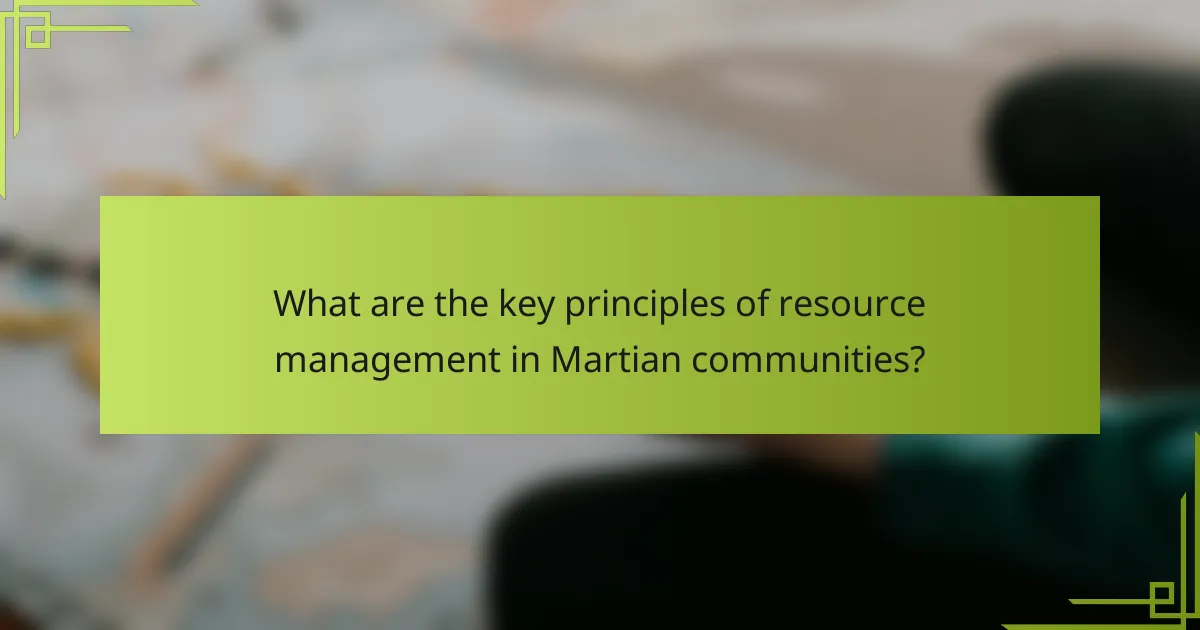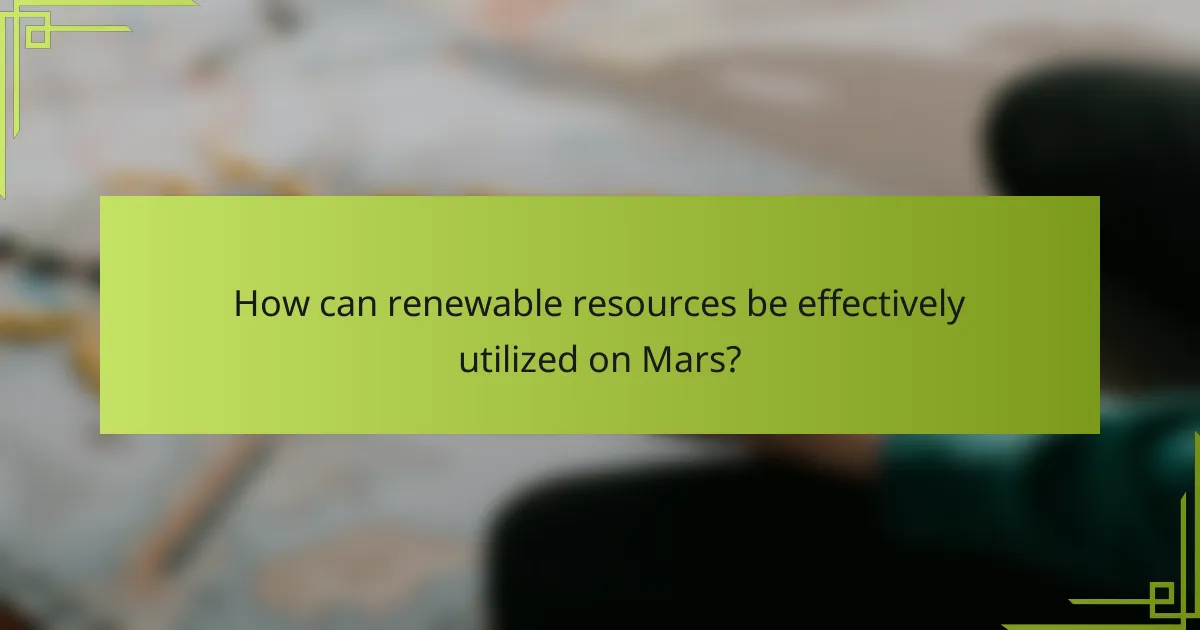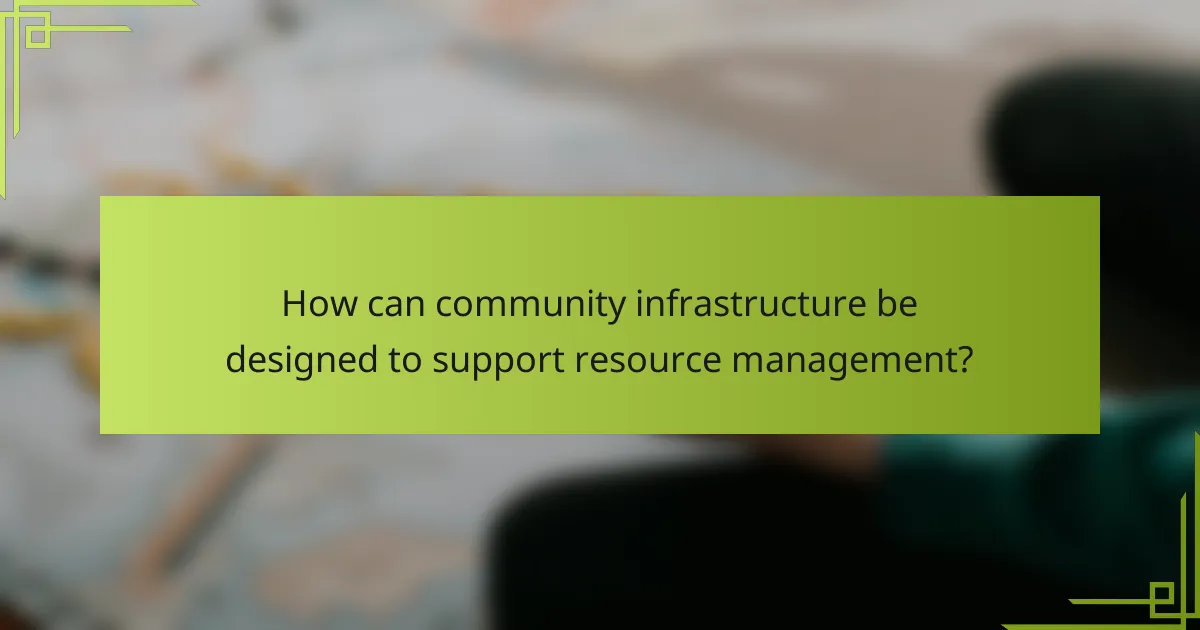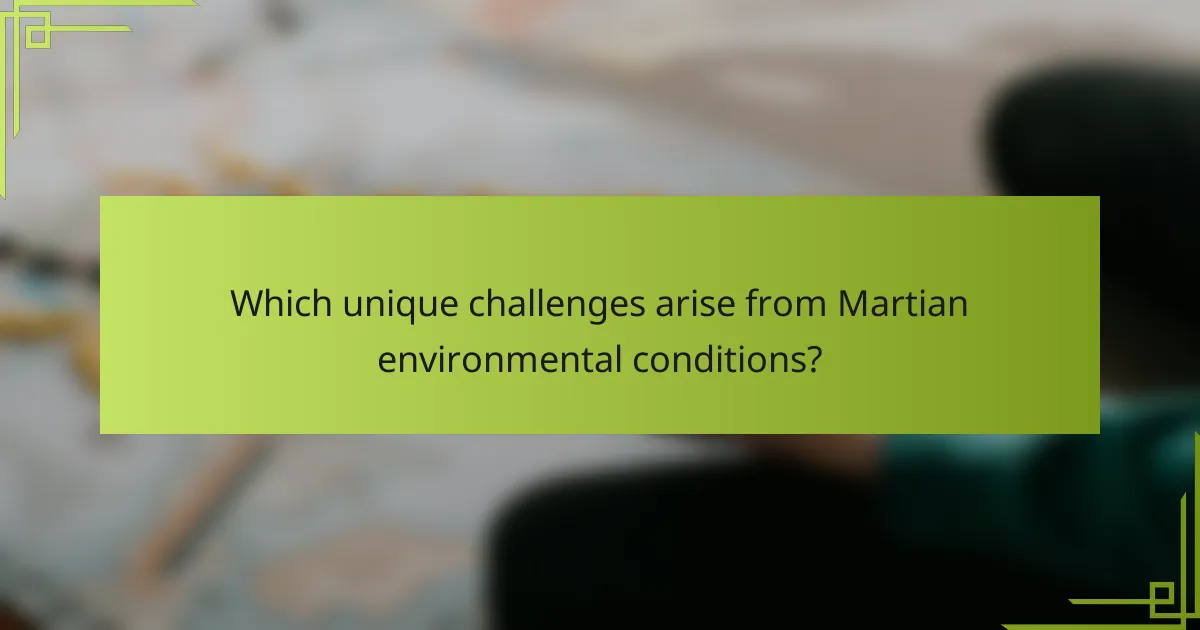Effective resource management is crucial for the sustainable development of Martian communities. This article explores key techniques such as resource allocation, waste management, and energy efficiency. It also examines community collaboration and technological integration to optimize resource use. Understanding Martian environmental challenges will further enhance strategies for resilience and sustainability in these colonies.

What are the key principles of resource management in Martian communities?
Effective resource management in Martian communities focuses on sustainability, efficiency, and technological integration. Key principles include maximizing resource utilization, recycling materials, and employing renewable energy sources.
1. Resource Allocation: Prioritize essential supplies like water and oxygen.
2. Waste Management: Implement systems for recycling and repurposing waste.
3. Energy Efficiency: Utilize solar panels and other renewable energy technologies.
4. Community Collaboration: Foster teamwork to enhance resource sharing and innovation.
5. Technological Integration: Use advanced technologies for monitoring and optimizing resource use.
How does resource scarcity influence community development on Mars?
Resource scarcity significantly impacts community development on Mars by necessitating efficient resource management techniques. These techniques include recycling water, utilizing solar energy, and optimizing food production through hydroponics. Effective management of limited resources fosters sustainable living conditions and supports population growth. As a result, Martian communities can thrive despite environmental challenges.
What role does technology play in optimizing resource allocation?
Technology plays a crucial role in optimizing resource allocation for Martian community development. Advanced data analytics and simulation tools enhance decision-making, ensuring efficient use of limited resources. Automated systems streamline supply chains, reducing waste and improving productivity. Additionally, real-time monitoring technologies provide insights into resource consumption, enabling timely adjustments. These innovations support sustainable growth in the challenging Martian environment, ensuring that community needs are met effectively.
Which resources are most critical for sustaining life on Mars?
Water, oxygen, food, and energy are critical resources for sustaining life on Mars. Efficient management of these resources ensures survival and community development.
Water is essential for hydration, agriculture, and oxygen production through electrolysis. Oxygen is crucial for respiration and can be generated from Martian regolith or produced from water. Food sources, including hydroponic systems, will provide necessary nutrients. Energy, primarily from solar panels or nuclear reactors, powers habitats and life support systems.
Establishing a sustainable cycle for these resources will enhance resilience against Martian challenges. For example, recycling water and using local materials can minimize reliance on Earth supplies.

How can renewable resources be effectively utilized on Mars?
Renewable resources on Mars can be effectively utilized through solar energy, wind energy, and water extraction. Solar panels can harness abundant sunlight for power generation, while wind turbines can take advantage of Martian winds. Water extraction from ice deposits supports life and agriculture. These strategies promote sustainable community development.
What are the benefits of solar energy for Martian habitats?
Solar energy provides essential benefits for Martian habitats, enhancing sustainability and resource management. It enables efficient energy production, reduces reliance on Earth supplies, and supports life-support systems. Solar panels can harness sunlight for power, facilitating water purification and food growth. This renewable energy source is crucial for long-term community development on Mars.
How can water recycling systems enhance sustainability?
Water recycling systems significantly enhance sustainability by reducing resource consumption and minimizing waste. These systems allow Martian communities to reclaim and reuse water, a critical resource in a harsh environment. By integrating advanced filtration and purification technologies, communities can ensure a continuous supply of clean water. This practice not only conserves water but also decreases the need for transporting water from Earth, lowering overall mission costs and environmental impact. Moreover, efficient water management fosters agricultural development, supporting food production and community growth on Mars.

What strategies are effective for managing food production in Martian colonies?
Effective strategies for managing food production in Martian colonies include utilizing hydroponics, optimizing resource recycling, and implementing controlled environment agriculture. These techniques enhance sustainability and food security in harsh conditions.
Hydroponics allows for soil-less cultivation, reducing water use by up to 90%. This method can produce food quickly, providing essential nutrients to colonists. Optimizing resource recycling involves repurposing waste materials into fertilizers, minimizing the need for external supplies. Controlled environment agriculture ensures stable growth conditions, protecting crops from radiation and temperature fluctuations.
Additionally, integrating automated systems can improve efficiency and reduce labor demands. These strategies collectively create a resilient food production system essential for long-term Martian habitation.
How does hydroponics contribute to food security on Mars?
Hydroponics significantly enhances food security on Mars by enabling efficient crop production in controlled environments. This method utilizes nutrient-rich water instead of soil, allowing plants to grow faster and with fewer resources. Hydroponic systems can be optimized for limited water and space, crucial for Martian conditions. Additionally, these systems can recycle water, minimizing waste and ensuring sustainable food sources for future Martian communities.
What are the challenges of farming in Martian soil?
Farming in Martian soil presents significant challenges due to its unique composition and environmental conditions. The primary issues include low nutrient levels, high salinity, and extreme temperatures.
Martian soil lacks organic matter, which is essential for plant growth. This deficiency requires innovative fertilization techniques to enhance nutrient availability. Additionally, the soil’s high salt content can hinder seed germination and plant health, necessitating the development of salt-tolerant crop varieties.
Extreme temperature fluctuations pose another challenge. Daytime temperatures can reach up to 20 degrees Celsius, while nighttime temperatures may drop to minus 73 degrees Celsius. This requires the implementation of protective farming structures to maintain optimal growing conditions.
Lastly, the thin atmosphere presents difficulties in water retention. Effective irrigation systems must be designed to minimize water loss and maximize plant hydration. Addressing these challenges is crucial for sustainable farming and community development on Mars.

How can community infrastructure be designed to support resource management?
Community infrastructure can be designed to support resource management by integrating sustainable practices, optimizing energy use, and enhancing collaboration. Effective designs include multifunctional spaces that promote recycling and renewable energy. For instance, solar panels can power communal facilities while waste management systems can be strategically placed to encourage proper disposal and recycling.
Additionally, establishing clear pathways for resource distribution fosters collaboration among community members. Implementing educational programs on resource conservation can also enhance awareness and participation.
By prioritizing these elements, Martian communities can ensure efficient resource management, ultimately supporting their development and sustainability.
What are the essential elements of a Martian habitat layout?
A Martian habitat layout must prioritize sustainability, resource efficiency, and safety. Essential elements include modular living spaces, renewable energy sources, water recycling systems, and agricultural zones.
1. Modular living spaces: Designed for adaptability and expansion, accommodating growth in population.
2. Renewable energy sources: Solar panels and wind turbines provide sustainable power.
3. Water recycling systems: Efficient systems ensure water conservation and reuse.
4. Agricultural zones: Hydroponics and aeroponics support food production in a controlled environment.
5. Radiation shielding: Structures must protect inhabitants from cosmic radiation.
6. Waste management systems: Effective disposal and recycling processes minimize environmental impact.
How does transportation affect resource distribution within Martian colonies?
Transportation significantly influences resource distribution in Martian colonies by enhancing accessibility and efficiency. Efficient transport networks ensure timely delivery of essential supplies, enabling sustainable community development. Various methods, such as rover systems and automated drones, can optimize logistics. Furthermore, central hubs for resource gathering can streamline distribution, reducing waste. Effective transportation systems directly correlate with improved resource management, fostering resilience in Martian environments.

Which unique challenges arise from Martian environmental conditions?
Martian environmental conditions present unique challenges such as extreme temperatures, low atmospheric pressure, and high radiation levels. These factors complicate resource management and community development on Mars.
Extreme temperatures can range from -125°C to 20°C, making it difficult to maintain habitable environments. Low atmospheric pressure, approximately 0.6% of Earth’s, affects the availability of water and air. High radiation poses health risks, necessitating protective structures for human habitats.
Resource management techniques must prioritize insulation, radiation shielding, and sustainable water recycling to overcome these challenges. Effective strategies will ensure the viability of Martian communities in this harsh environment.
How do dust storms impact resource accessibility?
Dust storms significantly hinder resource accessibility on Mars by disrupting supply routes and damaging infrastructure. These storms can last for days, reducing visibility and limiting solar energy collection, essential for powering habitats and equipment. Resource management techniques must adapt to these challenges by prioritizing stockpiling and developing efficient recycling systems. As a result, Martian communities can enhance resilience against the impacts of dust storms, ensuring continued access to vital resources.
What adaptations are necessary for Martian construction materials?
Martian construction materials require adaptations to withstand extreme temperatures, radiation, and low atmospheric pressure. These materials must be durable, lightweight, and capable of utilizing local resources.
1. **Thermal Resistance**: Materials should endure temperature fluctuations from -125°C to 20°C.
2. **Radiation Shielding**: Incorporation of materials that provide adequate protection against cosmic rays is essential.
3. **Low Pressure Tolerance**: Structures must maintain integrity under Martian atmospheric conditions, which are less than 1% of Earth’s.
4. **Resource Utilization**: Using in-situ resources like regolith for construction reduces reliance on Earth-supplied materials.
5. **Modular Design**: Prefabricated components can facilitate faster assembly and adaptability to various site conditions.
6. **Insulating Properties**: Materials should minimize heat loss to ensure energy efficiency in habitats.
These adaptations are crucial for the sustainability and safety of Martian communities.

What are the best practices for community engagement in resource management?
Effective community engagement in resource management on Mars involves collaboration, transparency, and education. Building trust among settlers encourages participation in decision-making processes. Regular workshops and feedback sessions ensure that community needs are addressed. Utilizing digital platforms for communication fosters inclusivity and accessibility. Incentivizing sustainable practices can enhance community involvement and promote resource conservation.
How can collaboration among colonists enhance resource sharing?
Collaboration among colonists enhances resource sharing by fostering community engagement and optimizing supply distribution. Effective teamwork allows for pooling of resources, which maximizes efficiency and minimizes waste. Shared responsibilities lead to enhanced problem-solving capabilities and innovation in resource management techniques. As a result, colonists can adapt more quickly to challenges, ensuring sustainable development on Mars.
What role does education play in promoting sustainable practices?
Education plays a crucial role in promoting sustainable practices by equipping individuals with knowledge and skills. It fosters awareness of environmental issues and encourages responsible resource management. For Martian community development, education can enhance understanding of resource conservation techniques, such as efficient water use and waste recycling. As a result, educated communities can implement innovative solutions that support long-term sustainability on Mars. This knowledge transfer is vital for adapting Earth-based practices to the unique challenges of a Martian environment.
What common mistakes should be avoided in Martian resource management?
Common mistakes in Martian resource management include over-extraction, neglecting sustainability, and poor planning. Over-extraction of resources can deplete vital supplies quickly. Neglecting sustainability leads to long-term ecological damage, which can jeopardize community survival. Poor planning often results in inefficient resource allocation, causing shortages. Prioritizing these aspects ensures a balanced and thriving Martian community.
What expert tips can optimize resource management strategies on Mars?
To optimize resource management strategies on Mars, implement efficient recycling systems and renewable energy sources. Prioritize water reclamation techniques, as water is essential for sustaining life. Utilize in-situ resource utilization to minimize reliance on Earth supplies. Establish a robust supply chain for essential materials to support community development. Engage in collaborative efforts with international partners to share knowledge and technology, enhancing overall sustainability.